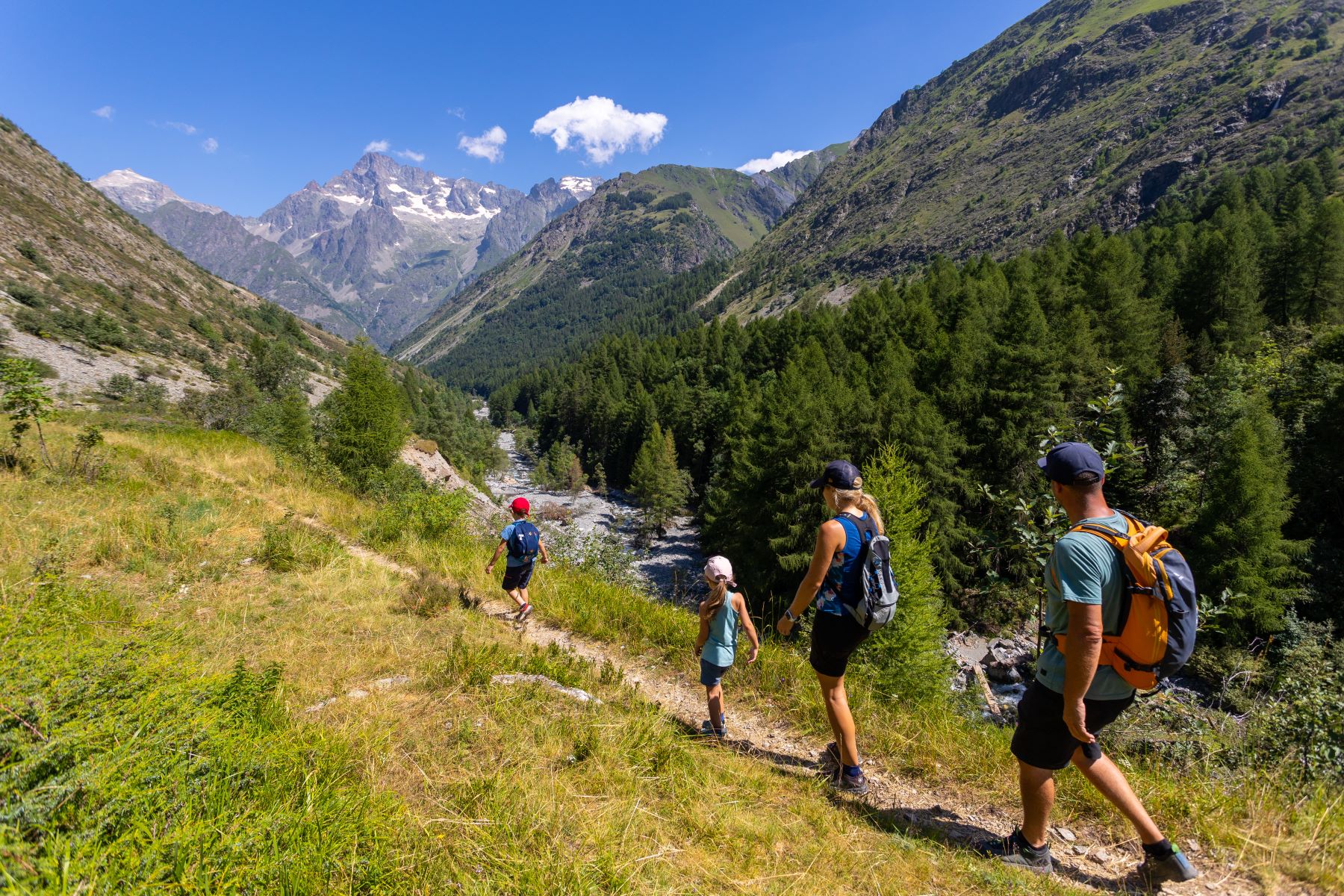
Navette Valley
On a hot summer’s day, on a shaded path, the ruins of the Navette hamlet, its restored chapel, ancient farmed terraces newly reforested and the « via clause » elevated path are there to evoke the charm of another time.
Description
At the Fouronnière car park, cross the stone bridge, then a second wooden one at the end of a short climb, to get to the ruins of Navette village. Cross Navette and continue on the path through the forest of Larch then Spruce, to rapidly reach the Buissard prairie. At its end, Buchardet waterfall reveals itself on the left. A small steep track enables you to better approach it. Cross the torrent on the wooden bridge and follow on in to the Larch forest taking a stone-walled path (via clause) before redescending to cross the Navette torrent and pass to the other side of the valley. At the crossroads, take a right to return to the Fouronnière car park by an elevated path overlooking the Navette torrent.
- Departure : Fouronnière
- Towns crossed : La Chapelle-en-Valgaudemar
22 points of interest

Dorine à feuilles alternes - PNE - Dentant Cédric  Flora
FloraGolden Saxifrage
The Golden Saxifrage has little yellow-green leaves positioned opposite each other. You can find it growing up to an altitude of 1 900 m near to wet rocks, seepages and fresh undergrowth.

Maison de Fouronnière - PNE - Vincent Dominique  Architecture
ArchitectureThe House at Fouronnière
The house at Fouronnière is the only house in the hamlet in its original "state" with vaulted stable and dwellings, the oven and barn. The stem at the back of the house enabled it to be resistant to avalanches. This building is privately owned, please respect this.

Wood shed near Navette (appentis) - PNE - Barker David  Architecture
ArchitectureLife on the slope
Groups of constructions were staggered across the sunnier slope. The best compromise in order to benefit from good sunlight and to stay away from the danger of avalanches, without impinging too much on the cultivatable land. Generally, the building was used as a dwelling, sheepfold and a place to stock foodstuffs and fodder. The volume of space given over to the farm was much greater than that destined for the dwelling (only 15%).

Hameau de Navette (Valgaudemar) et ancien pont Bonet vers 1920-1925 - PNE - Collection Catelan Jean-Claude  Vernacular heritage
Vernacular heritagePont Bonet
At one time, Bonet bridge enabled the crossing to Navette torrent. After the abandonment of the hamlet in 1930, the wooden bridge did not resist the ravages of time.

Gagée jaune - PNE - Dentant Cédric  Flora
FloraYellow Star of Bethlehem
The Yellow Star of Bethlehem possesses big wide leaves which distinguish it from the other plants of this species. It mainly grows in the woods. It flowers from April onwards. As its name indicates its flower is yellow. This plant species is protected throughout France.

Travaux de restauration - PNE - Baret Yves  Architecture
ArchitectureRestoration Navette Chapel
The building was restored in conformity with its original volumetry according to photographic archives. In order to best respect the memory of the chapel, the framework and the flooring were carried out in Larch wood from the surrounding area. The Lauze stone tiles for the roof were however imported. Fragments of the original mortar were found at the foot of the walls enabling the original colour of the paintwork to be established. . A pigmented milk of lime white-wash, was applied to the gable and the substructure. An important detail of religious architecture in Valgaudemar, the oculus, also called a ‘bull’s eye’ was identically preserved.

Chapelle de Navette vers 1920 - PNE - Collection Catelan Jean-Claude  Architecture
ArchitectureNavette Chapel
After the abandonment of the hamlet in 1930, Navette chapel did not survive the ravages of time. At the beginning of the 1980s, only the gable of the bell tower remained, though it was ready to fall down .On the 23rd June 1985, former inhabitants of Navette organized a pilgrimage for the Saint Jean-Baptiste, the patron saint of Navette. Thanks to stakeholders from the region and friends of Navette. A reconstruction project was put in place. On the 7th June 2002, the Bishop of Gap inaugurated the building. Since then, the hamlet comes alive again every first Sunday in July. A mass is organized in the chapel. Former inhabitants and those who love Navette get together for a picnic.

Exemple d'une toune à la Chapelle-en-Valgaudemar - PNE - Payan Simon  Architecture
ArchitectureToune
The ‘toune’ is an arcade situated on the principal façade of the dwelling. It sheltered materials like wood that were stocked and created a shelter where the entrance for the animals and sometimes for the people. The ‘toune’ was most often coated in white paint in order to reflect the heat of the sun. The inhabitants sat there while carrying out small jobs (embroidery, mending…).

 Architecture
ArchitectureStepped Gable
The saw-toothed or stepped gable attests to the roof previously having been thatched. This architectural specification is associated with the technique of thatching with rye straw. A salient wall divided in to steps. Salient Lauze tiles are lightly placed on to the gable in order to protect it from water infiltration, to protect the fillet and to stop the wind lifting the thatch. Associated with the chimney, the stepped gable limits the propagation of fires.

Paille - PNE - D'Houwt Stéphane  Architecture
ArchitectureThatched rooves
The roof covering of houses and out buildings varied throughout the ages. The thatched roof is made of plant material, like rye straw which was used in the past in Navette. It has the advantage of being a very good thermal insulator. After the terrible fires, thatch is less often used in favour of tiles made from Lauze, mainly coming from the quarry at Buffe cascade.

"Hameau de Navette vers 1935, après les premier départs des habitants. Sommet de l'Olan en fond" - Collection Catelan Jean-Claude - PNE  History
HistoryThe History of Navette
Life at Navette was difficult. In 1895, the houses with thatched rooves burnt. Then in 1914, the hamlet was flooded. Twice, the Navettins persevered and rebuilt their dwellings. However, after the second flood in 1928, the inhabitants lost faith. They left Navette and sold their land to the ONF which had engaged a vast program of reafforestation. Some elderly residents kept a link with their native land. In this way, on the first Sunday every July, Navette lives again.
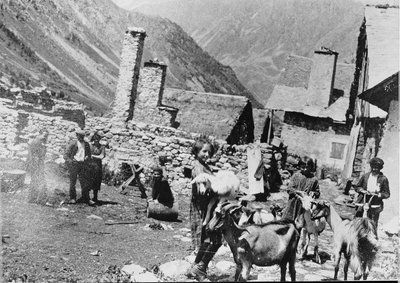
Hameau de Navette vers 1935 - PNE - Collection Catelan Jean-Claude  History
HistoryThe old way of live in Navette
In the past, the inhabitants went to collect wood in the surrounding area, sometimes at very high altitude. They had to descend with a load weighing several kilos on their back. The Navettins, inhabitants of Navette, did not possess much: seven to eight cows for the most "well off", a few goats, sheep or pigs for the others. The sheep and pigs were fattened up to be killed in the Autumn.
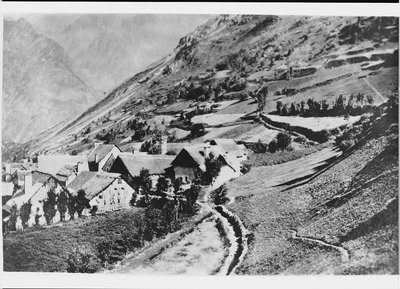
Hameau de Navette Valgaudemar, via clause et champs cultivés en terrasse (1900-1920) - PNE - Collection Catelan Jean-Claude  Vernacular heritage
Vernacular heritageVia clause
The ‘via clause’ is a path that follows the edge of cultivated fields. An essential passage way for the shepherds and their flocks, the ‘via clause’ is bordered by small walls delineating a sunken path. In this way the path contains the animals going up to the pastures. These little walls are built with stones collected in the nearby fields.

Jeunes cônes de mélèze - PNE - Chevalier Robert  Flora
FloraLarch
The Larch is the symbol of the bright Alps at tree with many uses, from the fountain to the roof. It is a vegetable rampart against avalanches and erosion. It accommodates hostile living conditions. But it does not like competition from other trees. Its needles filter the light and encourage rich vegetation.

La cascade de Buchardet à l'automne - PNE - Vincent Dominique  Water
WaterBuchardet Waterfall
Descending from the suspended valley of jas de la Lauze at the level of the glacial cross cliff, Buchardet torrent has carved a "connecting" canyon below the glacier at an altitude of between 1 700 and 1 400 m, through the crystalline base composed of migmatites or gneiss, metamorphic rocks which have been subjected to partial fusion. This connecting canyon links the Cros du Jas de Lauze suspended glacial cirque to the principal glacial valley, more deeply hollowed out and drained by the Navette torrent.. The steeper hillside of the Navette glacial trough is crossed in “cascades” by the Cros du Jas de la Lauze torrent. Erosion was facilitated by the rocks here that are mylonitised and pounded in a spindle of crushed rocks resulting from tectonic movements, which extends to the Tête Virante at Buchardet.

Cincle plongeur - PNE - Coulon Mireille  Fauna
FaunaWhite-throated Dipper
White-throated Dipper is easy to observe as long as you are discreet, it lives beside rivers and mountain torrents. A little red and grey bird, with a short tail, it has a fine beak, a white mark on the chin and on the chest. This astonishing sparrow has the particularity of being able to walk under the water against the current in search of food. It flattens itself down and grips on to the bottom with its claws, opens its eyes, which are protected from the flow by a fine membrane and spots worms, larvae, little crustaceans and fish.

Pic noir et ses petits dans le nid - PNE - Chevalier Robert  Fauna
FaunaBlack Woodpecker
This funny red bird with a red helmet and a long light coloured beak is the biggest woodpecker in the Alps. It is difficult to see because it is very solitary and distrustful. However, thanks to numerous clues that reveal its presence, it is possible to place its song and its very typical and sonorous. It taps endlessly to defend its territory and to find bark beetles or carpenter ants.
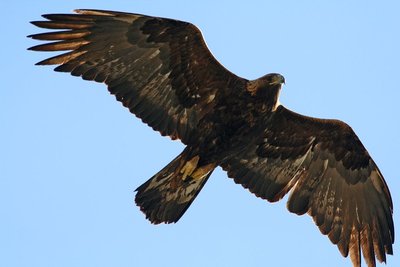
Aigle royal - PNE - Couloumy Christian  Fauna
FaunaRoyal Eagle
The Royal Eagle is one of the most rare and protected species in Europe. Its large size, its dark colouring, its rectangular wings and its frequent movements in the open air enable it to be easily recognized. In the hottest hours of the day, it turns about regularly benefiting from the rising wind in order to gain altitude. Thanks to its excellent sight the Royal Eagle scans its surroundings in search of an imprudent marmot or a young chamois. In winter it regularly feeds off the cadavers of animals.

Faon caché dans la végétation - PNE - Vincent Dominique  Fauna
FaunaRoe Deer
Animal of the borders, it is at the edge of the woods, in the clearing at dawn and dusk that the deer lets itself be seen, especially in winter when the animals group together in small herds. In the shadow, their mirror, that white heart shaped mark under the tail for the female and the form of a ben for the male sometimes gives them away. Delicate, agile and rapid, the deer is very discreet but leaves prints of its frail hooves in the snow or the mud right up at the alpine level. It is also remarkable by its strong « voice » a powerful bark when it is disturbed. At the beginning of its life, the fawn is covered with white marks which camouflage it. This « bambi » often stays lying on the grass. If you discover one, do not touch it, it has not been abandoned.

Petit Apollon - PNE - Albert Christophe  Fauna
FaunaPetit Apollon
A hardly perceptible rustling in the frozen morning grass betrays the presence of a butterfly disturbed by our steps and unable to use its damp wings... A few delicate jerks and there it is clinging onto some dry grass, then with successive spasms, it opens its pearly wings which are almost translucent in the sunshine. Its white wings possess miniscule red ocelli. The Small Apollo is a rare species and is protected.
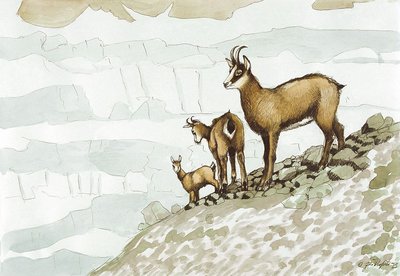
Une famille chamois - PNE - Projecto José Martins  Fauna
FaunaChamois
Emblematic animal of the Alps, le chamois or « rock goat » has short black, curled horns Like the ibex it is easier to see it through binoculars. The goats and esterlons (one year old males) like to be part of a big herd; however, the billy goats stay rather isolated only joining the females during the mating season. In the winter the chamois stay very quiet in order to preserve their reserve of fat. By staying on the track, the Chamois is easily visible on the facing slope.
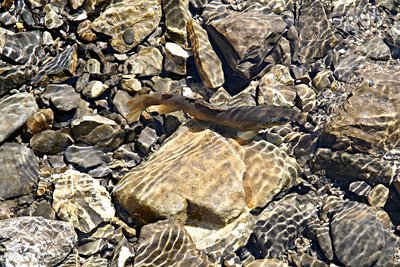
La truite fario - PNE - Telmon Jean-Philippe  Fauna
FaunaBrown Trout
The Brown Trout is a mountain fish ‘par excellence’. It lives in the oxygen rich fresh water currents. It cannot survive in water at a temperature superior to 18°C. Like all salmonids, it possesses an adipose fin, situated between the dorsal and the caudal fins, a head with a pointed muzzle and a mouth full of small teeth. Its body is clear coloured, mottled with red and black.
Forecast
Altimetric profile
Sensitive areas
Golden eagle
- Impacted practices:
- Aerial, , Vertical
- Sensitivity periods:
- JanFebMarAprMayJunJulAug
- Contact:
- Parc National des Écrins
Julien Charron
julien.charron@ecrins-parcnational.fr
Recommandations
 In mountain pastures, protection dogs are there to protect the herds from predators (wolves, etc.).
In mountain pastures, protection dogs are there to protect the herds from predators (wolves, etc.).
When I hike I adapt my behavior by going around the herd and pausing for the dog to identify me.
Find out more about the actions to adopt with the article "Protection dogs: a context and actions to adopt".
Tell us about your meeting by answering this survey.
Information desks
Valgaudemar Park house
Ancien Asile Saint-Paul, 05800 La Chapelle-en-Valgaudemar
Information, documentation and a reception area with permanent and temporary exhibitions. La Maison du Parc is labeled "Tourism and Disability". Free admission. All animations of the Park are free unless otherwise stated.
Access and parking
At 21 km from St Firmin on the D58, then the D985a until the Chapel turn right, on to a narrow road, in the direction of the Portes hamlet then reach Fouronnière. Between Portes hamlet and Fouronnière, access is via an unsurfaced track.
Accessibility
- Accessibility level :
- Experimented
- Emergency number :
- 114
Source

Report a problem or an error
If you have found an error on this page or if you have noticed any problems during your hike, please report them to us here:


